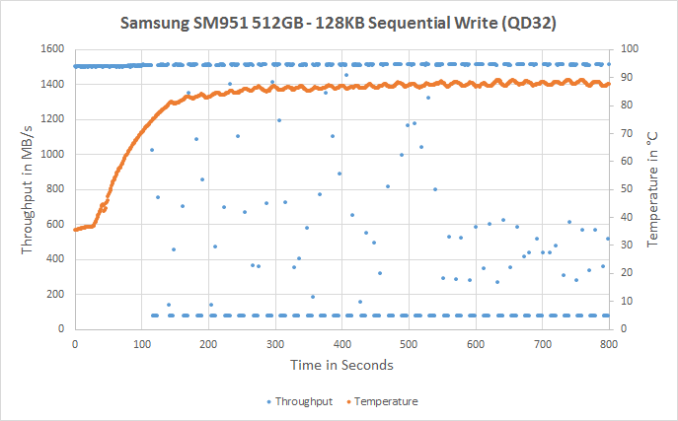Samsung SM951 (512GB) PCIe SSD Review
by Kristian Vättö on February 24, 2015 8:00 AM ESTThermal Throttling
In the previous pages I mentioned I have suspicions that some of the results have been affected by thermal throttling. To confirm my hypothesis, I took my datalogging multimeter and taped its thermal probe on top of the SM951's controller. Then I ran a 128KB sequential write test at queue depth of 32 and plotted the results in the graph below.
Now it's pretty clear why the performance seemed a bit low in the sequential tests. It takes less than two minutes for the drive to begin throttling itself and the performance drops to ~75MB/s. Because the SM951 is an M.2 drive, it doesn't have a chassis or heatsink to help with the heat dissipation, which combined with the fact that the SM951 is more power hungry than most SATA 6Gbps drives results in throttling issues. That said, the drive shouldn't throttle under normal usage because a continuous two-minute transfer isn't very common, but in some more IO intensive workloads with long transfers (e.g. video editing) there's a chance that performance will be affected by thermal issues.
In any case, I strongly recommend having a decent amount of airflow inside the case. My system only has two case fans (one front and one rear) and I run it with the side panels off for faster accessibility, so mine isn't an ideal setup for maximum airflow.
TRIM Validation
The move from Windows 7 to 8.1 introduced some problems with the methodology we have previously used to test TRIM functionality, so I had to come up with a new way to test. I tested a couple of different methods, but ultimately I decided to go with the easiest one that can actually be used by anyone. The software is simply called trimcheck and it was made by a developer that goes by the name CyberShadow in GitHub.
Trimcheck tests TRIM by creating a small, unique file and then deleting it. Next the program will check whether the data is still accessible by reading the raw LBA locations. If the data that is returned by the drive is all zeros, it has received the TRIM command and TRIM is functional.
In the case of the SM951, TRIM appears to be working properly.












128 Comments
View All Comments
Kristian Vättö - Tuesday, February 24, 2015 - link
PCIe adapters are fine for review purposes and are in fact more easily serviceable than M.2 slots tend to be.Samus - Tuesday, February 24, 2015 - link
Thank you for pointing out all capacities are M2 2280 DOUBLE SIDED. That is missing from virtually all reviews, sales material and eCommerce sites for M2 drives. Newegg has been pretty good about taking pictures of both sides of many drives, though.This is important to me because I work with HP Elitebook's and the newest generation of the Elitebook 810 (G2) and 820\1040 all require single-sided. The 840 has room for M2 DS modules, though.
Flash13 - Tuesday, February 24, 2015 - link
The company is not trustworthy! Buy at your own risk. Good Luck.youtard - Tuesday, February 24, 2015 - link
hurr!Wardrop - Tuesday, February 24, 2015 - link
Does this form factor work in standard desktop PCI-e 4x slots?DanNeely - Tuesday, February 24, 2015 - link
It's an m-2 plug, you need an adapter to fit it in a standard pcie slot.wtallis - Wednesday, February 25, 2015 - link
When discussing NVMe, please make it clear that the chipset and motherboard firmware only matter for booting off the drive; they don't need any updates to allow a compatible operating system to access the drive as something other than the boot volume.(As for what the motherboard firmware needs to gain in order to allow booting from NVMe devices, it's just a loadable UEFI device driver. Even if your motherboard doesn't have such a driver built-in, you could load it from some other storage device and then boot off the NVMe drive.)
ericgl21 - Wednesday, February 25, 2015 - link
I wonder if Samsung (or any other OEM) would be willing to sell a 1TB m.2 NVMe PCIe3.0 x4 SSD with SLC NAND with a 2280 form factor?Many professionals would appreciate the speed and reliability that SLC NAND provides.
Sure, it would cost a lot, but so do the Samsung SM951 and Intel P3700.
If that's not possible with current 16nm manufacturing, then a 512GB would also be nice. :-)
Just my 2 cents.
baii9 - Wednesday, February 25, 2015 - link
reliable on nand? Reliable controller matters, high endurance nand matters, I think nand are "reliable' enough already(compare to that lovely controller).IlikeSSD - Wednesday, February 25, 2015 - link
looks like Samsung paid for not showing OCZ in consistency and mixed workload tests )))))